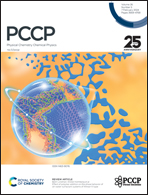Insight into melting point differences of dinitroimidazoles and dinitropyrazoles from the perspective of intermolecular interactions†
Abstract
Dinitroimidazole (DNI) and dinitropyrazole (DNP), along with their congeners, possess similar molecular structures but exhibit distinct melting points. To analyse and elucidate the fundamental reasons for property differences from the perspective of intermolecular interactions, we proposed a simplified approach named binding energy in clusters (BEC) in computing weak interactions within complex crystal systems. Based on the results of the symmetry-adapted perturbation theory (SAPT) calculations, an approximate estimation of the melting point range can be derived by taking into account the cumulative effect (energy of electrostatic, dispersion and induction terms) and repulsive effect (energy of exchange term) values. We have also proposed a formula for calculating the specific melting point, which indicates that stronger intermolecular interactions have a major impact on the melting point, while the distribution of weak interactions also affects the melting point. This work would provide an effective reference for molecular design and structure–performance analysis.



 Please wait while we load your content...
Please wait while we load your content...